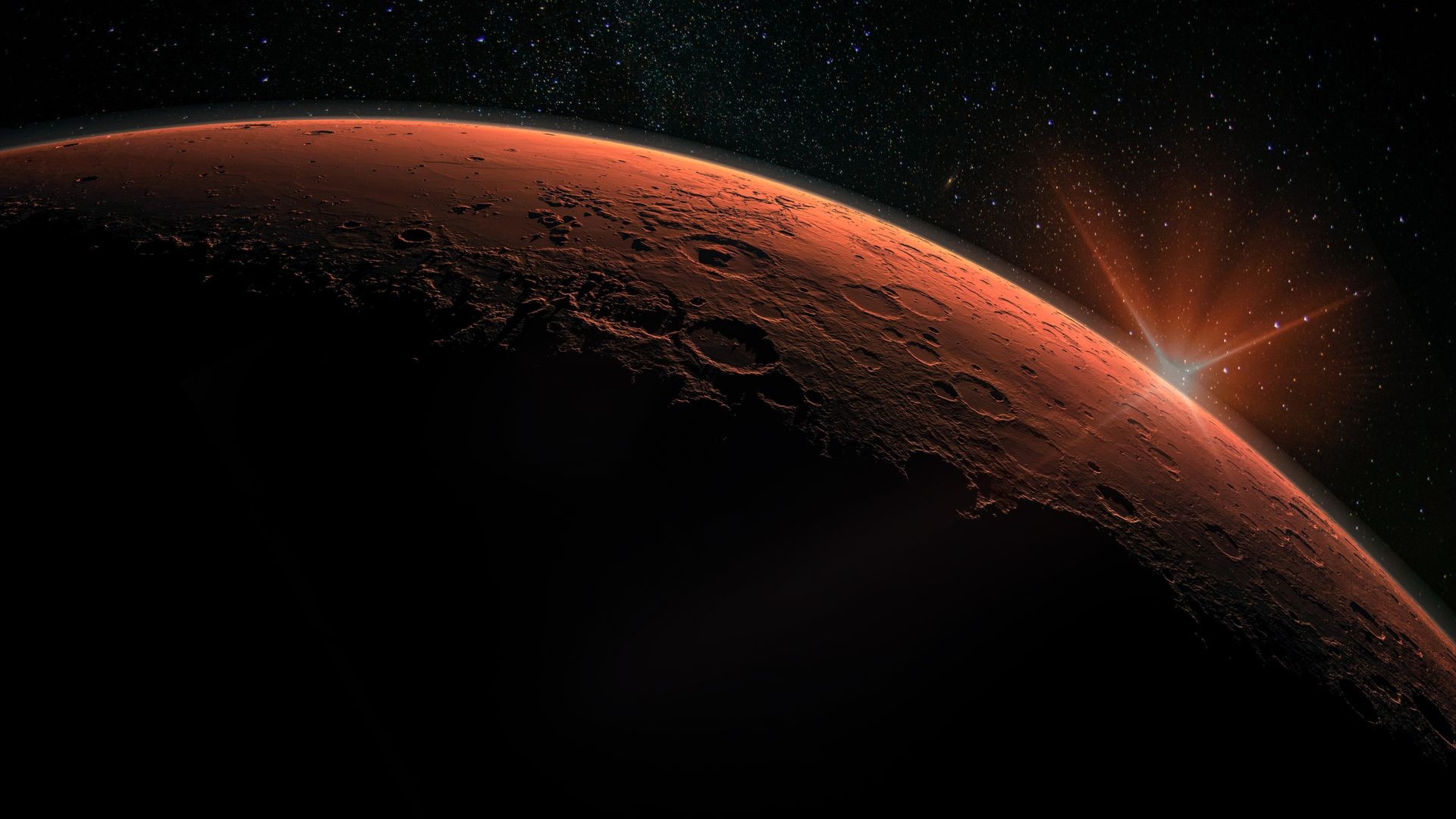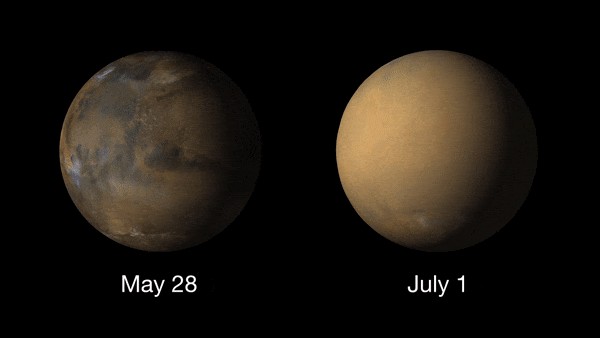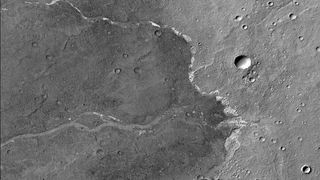Understanding the Martian atmosphere compared to Earth’s is crucial for space exploration, and COMPARE.EDU.VN offers a comprehensive analysis. This article delves into the atmospheric density, composition, climate, and historical evolution of Mars, providing a clear comparison with Earth and highlighting the challenges and possibilities for future Martian endeavors. Explore planetary atmospheres and atmospheric pressure to gain insights into the Red Planet’s unique characteristics.
1. Introduction: Comparing Martian and Terrestrial Atmospheres
The question, “How Thick Is Mars Atmosphere Compared To Earth?” is fundamental to understanding the Red Planet’s environment and its potential for future human habitation. Mars’ atmosphere is significantly thinner than Earth’s, impacting its climate, surface conditions, and the feasibility of supporting life. At COMPARE.EDU.VN, we provide an in-depth comparison of these two planetary atmospheres, examining their composition, pressure, temperature, and historical evolution. By analyzing these factors, we aim to offer a comprehensive understanding of the Martian atmosphere and its implications for space exploration, terraforming possibilities, and astrobiology. This analysis touches on key aspects of planetary science and space exploration, including atmospheric density, gas composition, and climate dynamics.
2. Density Disparity: A Quantitative Comparison
2.1 Atmospheric Pressure on Mars and Earth
The most striking difference between the atmospheres of Mars and Earth is their density. Atmospheric pressure, measured in millibars (mbar) or Pascals (Pa), provides a quantitative measure of this difference.
- Earth: At sea level, Earth’s atmospheric pressure averages around 1013.25 mbar (101.325 kPa).
- Mars: In contrast, Mars has an average surface pressure of only about 6.35 mbar (0.635 kPa).
This means Mars’ atmosphere is approximately 100 times thinner than Earth’s. The lower atmospheric pressure on Mars significantly impacts its environment, influencing temperature regulation, the presence of liquid water, and the intensity of solar radiation reaching the surface.
2.2 Implications of Low Atmospheric Density
The low atmospheric density on Mars has several crucial implications:
- Temperature Regulation: A thin atmosphere has less capacity to trap heat, leading to extreme temperature variations. Mars experiences significant temperature swings between day and night.
- Liquid Water: At such low pressure, liquid water cannot persist on the surface of Mars. It either freezes or evaporates (sublimates) rapidly.
- Radiation Exposure: The thin atmosphere provides minimal protection from solar and cosmic radiation, posing a challenge for any potential life forms or human missions.
- Aerodynamic Effects: The low density affects aerodynamic forces, making it challenging to design spacecraft and rovers that can effectively navigate the Martian atmosphere.
3. Atmospheric Composition: What Gases Dominate?
3.1 Earth’s Atmospheric Composition
Earth’s atmosphere is primarily composed of:
- Nitrogen (N2): Approximately 78%
- Oxygen (O2): Approximately 21%
- Argon (Ar): Approximately 0.9%
- Trace gases: Including carbon dioxide (CO2), neon (Ne), helium (He), methane (CH4), and water vapor (H2O)
The presence of abundant oxygen is crucial for supporting life as we know it. The ozone layer, formed by oxygen, also protects the surface from harmful ultraviolet radiation.
3.2 Mars’ Atmospheric Composition
Mars’ atmosphere has a very different composition:
- Carbon Dioxide (CO2): Approximately 95.32%
- Nitrogen (N2): Approximately 2.7%
- Argon (Ar): Approximately 1.6%
- Oxygen (O2): Approximately 0.13%
- Trace gases: Including carbon monoxide (CO), water vapor (H2O), and methane (CH4)
The dominance of carbon dioxide and the lack of substantial oxygen make the Martian atmosphere unbreathable for humans without specialized equipment.
Alt Text: Rusty red surface of Mars under sunlight, illustrating the thin atmosphere.
3.3 Comparative Analysis of Gas Abundance
| Gas | Earth (Approximate %) | Mars (Approximate %) |
|---|---|---|
| Nitrogen (N2) | 78 | 2.7 |
| Oxygen (O2) | 21 | 0.13 |
| Carbon Dioxide (CO2) | 0.04 | 95.32 |
| Argon (Ar) | 0.9 | 1.6 |



This table clearly illustrates the stark differences in atmospheric composition between Earth and Mars, emphasizing the challenges for future human colonization of the Red Planet.
4. Martian Climate and Weather Patterns
4.1 Temperature Extremes on Mars
Mars experiences extreme temperature variations due to its thin atmosphere and greater distance from the Sun. The average temperature on Mars is about -60°C (-76°F), but temperatures can range from -125°C (-193°F) near the poles in winter to 20°C (68°F) at the equator during summer days.
4.2 Seasons on Mars
Like Earth, Mars has seasons, but they are more pronounced due to the planet’s elliptical orbit. A Martian year is about 687 Earth days, nearly twice as long as an Earth year. The length of each season varies due to the planet’s orbital dynamics.
| Season (Northern Hemisphere) | Length of Martian season (sols) | Length of Earth season (days) |
|---|---|---|
| Spring | 194 | 93 |
| Summer | 178 | 93 |
| Autumn | 142 | 90 |
| Winter | 154 | 89 |
These seasonal variations impact the behavior of the polar ice caps and atmospheric dynamics.
4.3 Dust Storms: A Dominant Weather Phenomenon
One of the most notable weather phenomena on Mars is its massive dust storms. These storms can engulf the entire planet, lasting for weeks or even months. Dust particles in the atmosphere absorb sunlight, leading to atmospheric warming and altering wind patterns.
Alt Text: GIF illustrating the progression of a global dust storm on Mars in 2018, impacting visibility.
4.4 Water Ice and Snowfall
Although liquid water is unstable on the surface, water ice exists in the polar regions and subsurface. Mars also experiences snowfall, though it is composed of carbon dioxide crystals rather than water ice.
5. Historical Evolution of Mars’ Atmosphere
5.1 Early Martian Atmosphere
Scientists believe that early Mars had a much thicker atmosphere, potentially capable of supporting liquid water on its surface. Evidence for this includes ancient riverbeds, lake basins, and mineral deposits that form in the presence of water.
5.2 Loss of Atmospheric Density
Over billions of years, Mars lost much of its atmosphere. Several factors contributed to this loss:
- Solar Wind Stripping: The lack of a global magnetic field left the atmosphere vulnerable to the solar wind, which gradually stripped away atmospheric gases.
- Impact Events: Large asteroid impacts could have ejected significant amounts of atmosphere into space.
- Geological Processes: Changes in volcanic activity and internal processes may have also affected the atmosphere’s composition and density.
5.3 Evidence from MAVEN Mission
NASA’s MAVEN (Mars Atmosphere and Volatile Evolution) mission has provided valuable insights into the processes that led to the loss of Mars’ atmosphere. MAVEN has shown that the solar wind is still stripping away atmospheric gases today, albeit at a slower rate.
6. Current Research and Future Exploration
6.1 MOXIE Experiment: Generating Oxygen on Mars
The Mars Oxygen In-Situ Resource Utilization Experiment (MOXIE) on the Perseverance rover has successfully demonstrated the production of oxygen from Martian carbon dioxide. This technology could be crucial for future human missions, providing a sustainable source of breathable air and rocket propellant.
6.2 Future Missions to Study the Martian Atmosphere
Several future missions are planned to further study the Martian atmosphere, including orbiters, landers, and rovers. These missions will provide more detailed data on atmospheric composition, dynamics, and the planet’s climate history.
6.3 Terraforming Mars: Possibilities and Challenges
Terraforming is the hypothetical process of modifying a planet’s atmosphere, temperature, surface topography, and ecology to be similar to Earth’s environment, so that it can be habitable for humans and other life forms without the need for life support systems. The low atmospheric density and lack of a global magnetic field on Mars present significant challenges for terraforming. Increasing the atmospheric pressure, adding oxygen, and establishing a protective magnetic field would be necessary, but these are daunting tasks.
7. Expert Insights on Mars’ Atmosphere
7.1 Perspectives from Planetary Astronomers
Planetary astronomers study the atmospheres of planets and moons using telescopes, spacecraft, and computer models. Their research helps us understand the complex processes that shape planetary environments.
7.2 Timothy A. Livengood’s Q&A on Martian Atmosphere
Q: How and why might the composition of Mars’s atmosphere change periodically?
A: The atmosphere of Mars changes over the course of a day because the ground gets extremely cold at night, down to around minus 160°C. At such cold temperatures, both major and minor constituents of the atmosphere might either condense (snow, frost) or just stick to the soil grains a lot more than they do at warmer temperatures. Because of differing condensation temperatures and “stickiness”, the composition can change significantly with the temperature.
Q: Why do scientists think that Mars used to have a much thicker atmosphere?
A: The most obvious reason to think that Mars once had a much more dense atmosphere is that there are clear signs all over Mars of erosion by water in processes that occur on Earth but could not occur on Mars as it is today. There are river channels, eroded valleys, rocks worn into round river cobbles and dumped at the end of valleys, consistent with the way that rivers deposit rocks.
Q: Besides thickness, how might Mars’s atmosphere be different from its atmosphere when it was a more Earth-like planet?
A: Mars once was a more Earth-like planet, but it was the ancient Earth that it resembled, a planet with a CO2-rich atmosphere and no free oxygen, with extensive oceans that may have been frozen-over much of the time.
Q: How can scientists learn more about what the Martian atmosphere used to be like?
A: The rocks remember. Many types of rock can only form at the surface, where water dissolves both the minerals and the atmosphere so that they can react with each other to form new compounds that can condense to form new minerals.
Alt Text: Salt deposits and craters on the Martian surface, suggesting a history of water presence.
8. Comparing Earth and Mars: A Comprehensive Table
| Feature | Earth | Mars |
|---|---|---|
| Atmospheric Pressure | ~1013.25 mbar | ~6.35 mbar |
| Major Gas | Nitrogen (78%), Oxygen (21%) | Carbon Dioxide (95.32%) |
| Average Temperature | ~15°C (59°F) | ~-60°C (-76°F) |
| Liquid Water | Stable on the surface | Unstable on the surface |
| Magnetic Field | Global magnetic field | No global magnetic field |
| Seasons | Moderate | Pronounced |
| Dust Storms | Rare | Frequent, can be global |
| Habitability | Highly habitable | Currently uninhabitable without support |
9. Future Implications: Colonization and Resource Utilization
9.1 Challenges of Human Colonization
The thin atmosphere of Mars poses significant challenges for human colonization:
- Life Support: Habitats must provide a pressurized, oxygen-rich environment.
- Radiation Shielding: Protection from solar and cosmic radiation is essential.
- Temperature Control: Maintaining stable temperatures within habitats is crucial.
- Resource Utilization: In-situ resource utilization (ISRU) technologies, such as MOXIE, will be necessary to produce oxygen, water, and other essential resources.
9.2 Potential for Resource Utilization
Despite the challenges, Mars offers potential resources that could support colonization:
- Water Ice: Water ice deposits can be used to produce drinking water, oxygen, and rocket propellant.
- Carbon Dioxide: Atmospheric carbon dioxide can be used to create methane for fuel and oxygen for breathing.
- Minerals: Martian soil contains minerals that could be used for construction and manufacturing.
10. Call to Action: Explore Further with COMPARE.EDU.VN
Understanding the Martian atmosphere compared to Earth is a complex but crucial endeavor for future space exploration. At COMPARE.EDU.VN, we are committed to providing detailed, objective comparisons to help you make informed decisions. Whether you’re a student, researcher, or space enthusiast, our resources offer valuable insights into the Red Planet’s environment. Don’t struggle with overwhelming information; visit COMPARE.EDU.VN to find comprehensive comparisons and analyses. Make your decisions with confidence, backed by our expert evaluations. For more information or assistance, contact us at 333 Comparison Plaza, Choice City, CA 90210, United States, Whatsapp: +1 (626) 555-9090, or visit our website at COMPARE.EDU.VN.
11. Frequently Asked Questions (FAQ)
Q1: How does the atmospheric pressure on Mars compare to Earth?
A1: Mars’ atmospheric pressure is about 100 times thinner than Earth’s.
Q2: What is the primary gas in Mars’ atmosphere?
A2: The primary gas in Mars’ atmosphere is carbon dioxide (CO2), making up about 95.32%.
Q3: Why is Mars so much colder than Earth?
A3: Mars is colder due to its thinner atmosphere and greater distance from the Sun.
Q4: Does it snow on Mars?
A4: Yes, but the snowflakes are made of carbon dioxide rather than water.
Q5: What is the MAVEN mission studying?
A5: The MAVEN mission is studying how Mars lost its atmosphere over billions of years.
Q6: Can humans breathe on Mars?
A6: No, the Martian atmosphere is not breathable for humans without specialized equipment.
Q7: What is the MOXIE experiment?
A7: The MOXIE experiment is generating oxygen from Martian carbon dioxide.
Q8: What are the biggest challenges for colonizing Mars?
A8: The biggest challenges include life support, radiation shielding, and temperature control.
Q9: What resources could be utilized on Mars?
A9: Water ice, carbon dioxide, and minerals could be utilized for colonization.
Q10: How do dust storms affect the Martian atmosphere?
A10: Dust storms absorb sunlight, leading to atmospheric warming and altering wind patterns.
12. Glossary of Terms
- Atmospheric Pressure: The force exerted by the weight of the atmosphere on a surface.
- Sublimation: The transition of a substance directly from the solid to the gas phase.
- In-Situ Resource Utilization (ISRU): The use of local resources to meet the needs of a mission or colony.
- Terraforming: The hypothetical process of modifying a planet to be more Earth-like.
- Solar Wind: A stream of charged particles emitted by the Sun.
- Planetary Atmosphere: The layer of gases surrounding a planet or other celestial body.
- Atmospheric Density: Mass per unit volume of a planet’s atmosphere.
- Gas Composition: Relative abundance of different gases in an atmosphere.
13. References
- NASA Mars Exploration Program
- European Space Agency (ESA) Mars Missions
- MAVEN Mission Data
- Published research papers on Martian atmosphere
- Space.com articles on Mars exploration
14. External Resources
- NASA’s Mars Exploration Website: https://mars.nasa.gov/
- ESA’s Mars Exploration Website: https://www.esa.int/Science_Exploration/Space_Science/Mars_Express
- MAVEN Mission Website: https://lasp.colorado.edu/maven/
- Space.com Mars Articles: https://www.space.com/topics/mars
15. About the Author
This article was created by a content specialist at COMPARE.EDU.VN with expertise in planetary science and space exploration. The information provided is based on reliable sources and aims to offer an objective comparison of Earth’s and Mars’ atmospheres.
Remember to visit compare.edu.vn for more detailed comparisons and resources to help you make informed decisions.
